A History of the County of Worcester: Volume 3. Originally published by Victoria County History, London, 1913.
This free content was digitised by double rekeying. All rights reserved.
'Parishes: Bishampton', in A History of the County of Worcester: Volume 3, (London, 1913) pp. 261-265. British History Online https://www.british-history.ac.uk/vch/worcs/vol3/pp261-265 [accessed 12 April 2024]
In this section
BISHAMPTON
Bisantune (fn. 1) (xi cent.); Byshampton, Bihampton (xiii cent.); Bissehamton (xvi cent.).
The parish of Bishampton lies in the south-eastern part of the county of Worcester. It is bounded on the north by Whitsun Brook, which ultimately runs into the River Avon, and is divided on the east from Church Lench by some wooded hills 300 ft. above the ordnance datum. These hills form the highest part of the parish, the north and east being at about 100 ft. above the ordnance datum. The area of the parish is 1,910 acres; 1,032 are arable, 733 acres are permanent grass, and 32 are woods. (fn. 2) The soil is chiefly marl clay and the subsoil partly Lower Lias and partly Keuper Marl. The chief crops are wheat, beans, barley, turnips and garden produce.
The chief roads are Gunning Lane, running west, and Broad Lane, running east, from the village of Bishampton, (fn. 3) and a third road on which the village lies running due south through the parish to Fladbury.
The village is situated about 9 miles south-east of Worcester, some distance to the south of the Alcester and Stratford road. It is grouped along a by-road running from north to south with the church at the north end. The small half-timber farm-houses and cottages of which the settlement is composed combine to invest it with a picturesque and old-world air. The Manor Farm to the south-west of the church is a half-timber house, dating probably from the early 17th century, covered with rough-cast and modernized. Attached to a farm and fronting on the road is a fine timber barn, weather-boarded and standing on a sandstone base. On the east side of the village street is a good half-timber house of the early 17th century, two stories in height, with a tiled roof, showing the ornamental timbering characteristic of the period. The gabled end wings have richly carved barge-boards, and in the gable of the southern wing is the date 1629; the figures are obviously modern work, though probably copied from an older inscription. Hayes Farm, at the lower end of the village on the east side of the road, is a small rectangular building of half-timber of the late 16th century. The chimney stacks are surmounted by brick shafts of the intersecting diagonal type. Pebworth House, to the south of Hayes Farm and upon the same side of the road, is a modernized house now faced with brick, but still preserving a fine stone chimney stack of the late 16th century with shafts of brick. To the south of Pebworth House is a 17th-century H-shaped house faced with brick and having an elaborately panelled chimney stack of the same material on the north. On the gable at this end is the date 1689 with the initials F. G.
An Inclosure Act for Bishampton was passed in 1795, (fn. 4) and the award is dated 1797. (fn. 5)
MANORS
Seven cassata of land at BISHAMPTON are said to have been given by King Edgar to the church of Worcester. (fn. 6) It is more probable, however, that Bishampton was in early times part of the manor of Fladbury, and came into the possession of the monastery when Fladbury was given to them. (fn. 7) In 1086 it was part of the manor of Fladbury, and one of the manors into which the parish afterwards became divided was held of the manor of Fladbury at least as late as 1419, (fn. 8) and probably later, as the overlordship of the Bishop of Worcester was recognized until 1525. (fn. 9)
At the date of the Domesday Survey the bishop's under-tenant at Bishampton was Roger de Lacy. (fn. 10) He was banished for his share in the rebellion against William Rufus, and his forfeited estates were bestowed on his brother Hugh de Lacy, who was the owner in 1108–18. (fn. 11) He died without male issue, and his estates passed to his two sisters.
Gilbert son of the second sister Emma assumed the name Lacy, and Roger de Lacy's interest in the manor passed in the Lacy family until the death of Walter de Lacy in 1241. The overlordship of Bishampton, which was attached to Weobly Castle, was assigned to Margery wife of John de Verdon, one of the granddaughters and co-heirs of Walter Lacy, (fn. 12) and passed from her to her son and grandson Theobald de Verdon. The last-named Theobald died without male issue in 1316, (fn. 13) and this fee was assigned in 1335–6 to one of his daughters, Elizabeth wife of Bartholomew de Burghersh. (fn. 14) Her son Bartholomew was succeeded by a daughter, Elizabeth wife of Edward le Despenser, and Edward was holding the fee in her right at the time of his death, about 1375. (fn. 15) The Lacys' interest in the manor seems to have lapsed after this time.
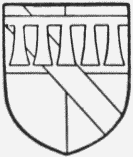
Lacy. Quarterly or and gules a bend sable and a label argent.
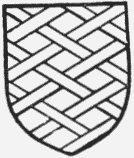
Verdon. Or fretty gules.
Two Frenchmen were holding Bishampton of Roger de Lacy in 1086, and the parish remained divided into two manors until the 17th century. Half the parish, 5 hides, was held by the Pichard family, (fn. 16) tenants under the Lacys in the neighbouring manor of Kington and in various estates in Herefordshire. John Pichard held Bishampton about 1182 as mesne lord under Hugh de Lacy, (fn. 17) and as at Kington his interest passed to Philip ap Howel. (fn. 18)
As at Kington the Pipard family held Bishampton under the Pichards. Robert Pipard was the tenant towards the end of the 12th century under John Pichard. (fn. 19) A Robert Pipard held the manor for the service of a knight's fee at the beginning of the 13th century. (fn. 20) At this point the manor seems to have been divided, part passing with Kington to Guy Pipard and part to William Pipard, who may have been a younger brother of Guy. (fn. 21) The latter seems to have been involved in financial difficulties, for in 1237 his manor of Bishampton was valued as a preliminary to the settlement of debts which he owed to David of Oxford, a Jew. (fn. 22) Guy's manor passed with that of Kington to his daughters, thus becoming vested in the Kardiff and Somery families. (fn. 23)
Henry de Somery was dealing with land in Bishampton in 1275, (fn. 24) and the manor had passed before 1297–8 to Robert de Somery. (fn. 25) Roger de Somery of Bishampton is mentioned in 1313, (fn. 26) and Richard de Somery held land there in 1315–16. (fn. 27) Robert de Somery endowed a chantry with land at Bishampton in 1320–1. (fn. 28) It was probably the same Robert who in 1333 settled the manor on himself and his wife Sibyl with reversion to Thomas de Somery and Julia his wife and their heirs, with contingent remainder to the heirs of Robert. (fn. 29) Robert died before 1337, when Thomas son of Thomas de Somery granted to the Abbot of Pershore a rent of 10 marks for the life of Sibyl widow of Robert de Somery. (fn. 30) Thomas de Somery of Bishampton obtained in the following year a grant of the bailiwick of the hundred of Oswaldslow. (fn. 31) Thomas de Somery appears to have been lord of the manor in 1340, (fn. 32) but it had passed before 1356 to Thomas de Lyttelton, (fn. 33) who was holding it in 1363 in right of his wife Julia. (fn. 34) She is said to have been a daughter of Robert de Somery. (fn. 35) It was probably the Lytteltons' manor at Bishampton which was held in 1411–12 by William Bryan and Margery his wife in her right and conveyed by them in that year to Alice wife of Sir Richard Stury, (fn. 36) who in 1412 gave it to the chantry which she had founded at Hampton Lovett. (fn. 37) At the Dissolution of the chantries this manor passed to the Crown and was granted in 1549 to John Cupper and Richard Trevor. (fn. 38) They immediately sold the manor to Henry Jones and Adam Lutley, who were evidently trustees for Sir John Pakington. (fn. 39) In the following year Sir John settled this manor on his daughter Ursula and her husband William Scudamore. (fn. 40) The manor then followed the same descent as Church Lench (q.v.) until the death of Sir William Keyt in 1741. (fn. 41) His son and successor Sir Thomas Charles Keyt (fn. 42) sold the manor in 1753 to Sir Dudley Ryder. (fn. 43) He died in 1756 and was succeeded by his son Nathaniel Ryder, who was created Lord Harrowby in 1776. (fn. 44) On the death of the latter in 1803 his son Dudley (fn. 45) succeeded. He was created Viscount Sandon and Earl of Harrowby in 1809 (fn. 46) and died in 1847, being succeeded by his son Dudley second Earl of Harrowby, (fn. 47) who sold the manor of Bishampton to the Duc d'Aumale about 1862. From him it passed to the Duc d'Orleans, who sold it in 1912 to Sir Charles Swinfen Eady.
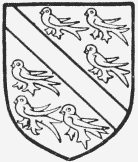
Somery. Sable a bend between six martlets argent.
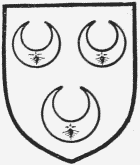
Ryder, Earl of Harrowby. Azure three crescents or with an ermine tail upon each.
The Kardiffs' moiety of the manor passed in the same way as Kington to William son of Paul de Kardiff, who succeeded to the estate in 1315. (fn. 48) It possibly passed from his descendants to the Somervilles in the same way as Kington, though little is known of their tenure of the manor. William Somerville of Aston Somerville was dealing with land at Bishampton in 1429–30, (fn. 49) and in 1561 John Somerville held 'the manor of Bishampton.' (fn. 50) At the time of his attainder in 1583 John Somerville was in possession of land in Bishampton which was parcel of the manor of Kington. (fn. 51) There is no further trace of this estate.
The other part of the Pipards' manor was apparently held by William Pipard in 1234 and 1240–1. (fn. 52) It was, perhaps, this estate which was sold in 1313–14 as land at Bishampton by William son of Cecily Pipard, kinsman and one of the heirs of Robert Pipard, to Guy de Beauchamp Earl of Warwick. (fn. 53) At the same date Alexander de Stonington, another co-heir of Robert Pipard, released all his right in the manor to the earl, who assigned part of the capital messuage of Bishampton as dower to the abovementioned Cecily, who was the widow of Robert Pipard. (fn. 54) Guy Earl of Warwick died seised of this estate, then called the manor of Bishampton, in 1315. (fn. 55) It is uncertain whether this estate remained in the possession of the Earls of Warwick or whether it is to be identified with a knight's fee at Bishampton held in 1346 by William de Shobdon, and described as 'late of Robert Pipard.' (fn. 56) Thomas Earl of Warwick at the time of his attainder in 1396 was in possession of land in Bishampton which was granted in 1397 to Thomas Lyttelton. (fn. 57) William de Shobdon had acquired some land at Bishampton in 1331–2 of Nicholas de Wyshaw and his wife Agnes, who seem to have held it in her right. (fn. 58) He was dealing with land at Bishampton in 1352, (fn. 59) and his son Thomas was holding land there in 1374. (fn. 60) In 1411 Thomas son of Thomas de Shobdon paid 53s. 4d. to the barony of Elmley for land in Bishampton, (fn. 61) and in 1480 Thomas son of Thomas Sheldon (sic) paid rent to Elmley Castle for this land. (fn. 62)
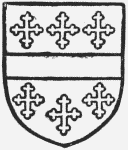
Beauchamp, Earl of Warwick. Gules a fesse between six crosslets or.
It was perhaps this estate which as the manor of Bishampton was held of the Bishop of Worcester in 1500–1 by Robert Throckmorton. (fn. 63) Thomas Throckmorton is said to have sold his land at Bishampton in 1594–5, (fn. 64) but Thomas Throckmorton died in 1615 holding rents from land in Bishampton, (fn. 65) and Habington, writing about the middle of the 17th century, states that Mr. Throckmorton held land there, (fn. 66) and Sir John Throckmorton in 1795 was holding certain quit-rents, heriots and services from land at Bishampton, due at his court of Throckmorton. (fn. 67)
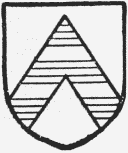
Throckmorton. Gules a cheveron argent with three gimel bars sable thereon.
The other manor at Bishampton was held under the Lacys by the family of Ferches or Furches, who were perhaps descendants of the second Frenchman who held of Roger de Lacy in 1086. The Lacys' overlordship seems to have lapsed before the beginning of the 13th century, the manor being held of the Bishop of Worcester as of the manor of Fladbury. (fn. 68) Herbert de Furches held it about 1182 as 5 hides under Hugh de Lacy, (fn. 69) and later it passed to Walter de Furches. (fn. 70) William de Furches held the manor at the beginning of the 13th century. (fn. 71) He had in 1200 succeeded his uncle Robert de Furches at Kingston in Herefordshire, and possibly also in this manor. (fn. 72) William or a descendant of that name was living in 1278, (fn. 73) but seems to have been succeeded before 1290 by his grandson Fulk de Lucy. (fn. 74)
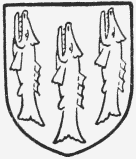
Lucy. Gules three luces rising argent.
His grandson William Lucy owned a knight's fee in 1346, (fn. 75) and was succeeded by his son Thomas, who in his turn was followed by his son William. (fn. 76) This William was succeeded by his son Thomas Lucy, (fn. 77) who died in 1415–16, having settled the manor of Bishampton on his brother William Lucy and his heirs. (fn. 78) William granted a third part of the manor to Alice, Thomas Lucy's window, as her dower. William Lucy died in 1419, and Alice, who had married as her second husband Richard Archer, died in the following year. Both were succeeded by William Lucy, the son of Thomas and nephew of William. (fn. 79) This William Lucy was the owner in 1428, (fn. 80) and died in 1466, being succeeded by his son William. (fn. 81) He was created a knight of the Bath at the coronation of the queen of Henry VII, (fn. 82) and died in 1492, being succeeded by his son Edmund Lucy, (fn. 83) who in his turn was followed in 1495–6 by his son Thomas Lucy. (fn. 84) Thomas was knighted in 1512 by Henry VIII, (fn. 85) and died in 1525. (fn. 86) There was some objection taken to the way his will was administered and to his title to the manor of Bishampton, (fn. 87) which he had left to his son William Lucy. (fn. 88) Ultimately his grandson Thomas Lucy sold the manor of Bishampton to Francis Walshe in 1561. (fn. 89) Richard son of Francis was succeeded by two daughter, Anne wife of Sir Thomas Bromley, and Joyce wife of Sir Roland Cotton, (fn. 90) who with their mother Katherine, then wife of Roger Palmer, and their uncle Edmund Walshe sold the manor in 1615 to William Keyt, (fn. 91) who bought the other portion of the manor from Sir John Scudamore in 1627. The descent of the manor then follows that of the manor of Bishampton first described (q.v.), and Sir Charles Swinfen Eady is now owner.
There was a mill worth 12d. at Bishampton in 1086. (fn. 92) It appears to have passed with a moiety of the manor to the chantry of Hampton Lovett, and is mentioned in 1549 as a late possession of the chantry. (fn. 93) There is no mill in the parish at the present day.
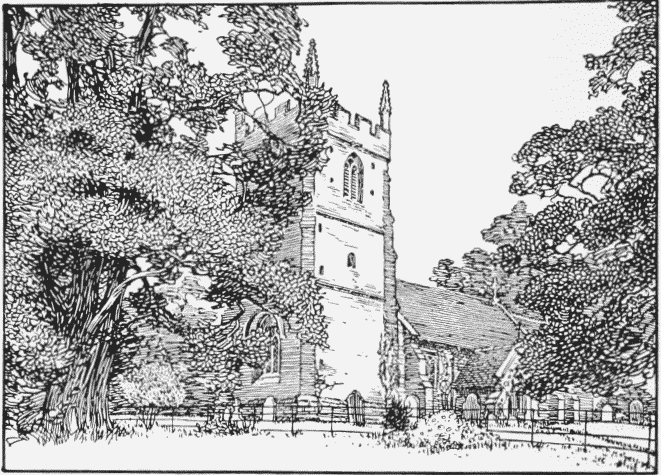
Bishampton Church from the South-west
CHURCH
The church of ST. JAMES consists of a chancel with vestry, nave, south porch and a western tower. It appears to preserve the plan of a 12th-century building, to which a western tower was added c. 1400. The nave and chancel were, however, completely rebuilt in 1870, the stonework of the doors and windows being reused where possible.
The modern east window of the chancel is of three lights, with tracery in the style of the 14th century. At the north-east is a single trefoiled light reset. The easternmost window of the south wall is a single trefoiled light with a deep reveal on both faces. Some of the stones appear to be old. The two westernmost windows in the wall are modern. The chancel arch is entirely modern. In the nave the first and second windows on the north are largely modern restorations. The 12th-century north door, now blocked, has a round head, but has been rebuilt. To the west of it is a single-light window with some remains of original 12th-century work. The first and third windows on the south, which are almost entirely modern, have tracery of 14th-century character in 14th-century style, and between them is a restored round-headed light of the 12th-century type.
The south door of the nave has a round head and shafted external jambs, with scalloped capitals, mostly original 12th-century work. The porch is modern.
The large tower forms the only portion of the church not rebuilt in 1870. It is of three stages, with angle buttresses of four offsets and an embattled parapet finished with modern pinnacles at the angles. The tower arch is of two orders, and the west window of the ground stage is of three lights with vertical tracery above. Each face of the belfry has a window of two lights, with a quatrefoil above. The southern has a sanctus bell, hung between the mullion and the western jamb, and below this window is another, with a plain single light. The belfry stair occupies the south-west angle of the tower. The circular bowl to the font is of the late 12th century, with roses, crosses and stars forming a band round the edge; the stem is modern.
The bells are six in number, inscribed as follows: the treble, 'Feare God, Honour the King 1690 Gulielmus Keyt Baronet Hujus Maneris 1690'; the second, the churchwardens' names 1690; the third, 'William Grimet 1690'; the fourth, 'William Bagley made me 1690'; the fifth, 'R. Sanders made me 1690'; the tenor, 'Fear God Honour ye King 1690.' The sanctus bell has no inscription and is of modern form. Till recently a muffled peal was rung commemorating the execution of Charles I.
The plate consists of a cup and cover paten made in 1778, inscribed 'John Windle A.M. Vicar,' with the churchwardens' names; an interesting paten, shell shaped, with two flat handles and repoussé work which is inscribed 'I.W. 1684.' There are also a small modern silver flagon, almsdishes and a pewter plate.
The registers are as follows: (i) bound in a parchment volume, mixed entries from 1599 to 1667; (ii) 1668 to 1693; (iii) 1694 to 1738; (iv) 1738 to 1811, the marriage entries ceasing at 1754, when a printed marriage book begins extending to 1812.
ADVOWSON
There was a priest and possibly a church at Bishampton in 1086. (fn. 94) The advowson evidently belonged to the Pipards' manor, for Robert de Somery presented in 1286 and 1290, (fn. 95) and in 1293–4 made an agreement with William de Kardiff and his wife Ivetta, co-heir of Guy Pipard, by which Somery and Kardiff were to present alternately, William and Ivetta making the first presentation. (fn. 96) It would seem, however, that a subsequent agreement must have vested the advowson in the Somerys, for it passed with their manor of Bishampton (fn. 97) until 1325–6, when Robert de Somery obtained licence to grant it to the nunnery of Cookhill. (fn. 98) The conveyance does not seem to have been completed until 1329. (fn. 99) The church was appropriated to the priory in 1331 (fn. 100) and the vicarage ordained in 1359. (fn. 101) For licence to appropriate the church the nuns undertook to pay the Bishop of Worcester 1 mark yearly. (fn. 102) The church of Bishampton remained appropriate to the priory of Cookhill until the Dissolution, (fn. 103) when it passed to the Crown. The advowson and rectory were granted in 1558 by Queen Mary to Richard Pates, Bishop of Worcester. (fn. 104) Pates was deprived on the accession of Elizabeth, but the rectory of Bishampton was granted to his successor Edwin Sandys in 1561. (fn. 105) Since this date the presentations to the church of Bishampton have always been made by the Bishop of Worcester with two exceptions, one in 1638, when Maurice Hiller presented, being patron in right of his wife, for one turn only, and the other in 1662, when the Crown presented, (fn. 106) the see of Worcester being vacant.
Bishampton appears at one time to have been a chapelry of Fladbury. In 1286 a composition was made between the rectors of Fladbury and Bishampton as to the profits of the chapel of Bishampton, and as a result the mortuaries of Bishampton were divided between the two rectors. (fn. 107)
A chantry of the Blessed Virgin in the parish church of Bishampton was founded by Robert de Somery in 1321, when he gave two messuages and lands and 20s. rent in Bishampton for that purpose. (fn. 108) The advowson descended with the Somerys' manor to Thomas Lyttelton, (fn. 109) and appears to have passed with it as the 'advowson of the church of the manor' to Alice Stury. (fn. 110) She must have conferred it upon the chantry of Hampton Lovett, for the chantry priests presented in 1424 and 1462. (fn. 111) The chantry was valued at the Dissolution at 40s. 2d., (fn. 112) and was granted to John Cupper and Richard Trevor with the manor of Bishampton, (fn. 113) and afterwards passed with the manor to John Pakington.
There were 2 acres of arable land worth 8d. a year at Bishampton, given for the maintenance of certain lights. (fn. 114) This estate was granted in 1611 to Francis Morice and Francis Phillips. (fn. 115)
There is a Baptist mission chapel in the town of Bishampton in connxion with Pershore. (fn. 116)
CHARITIES
The charities subsisting in this parish are administered together, comprising the following, namely:—
Mrs. Mary Wallbank, mentioned on the church table, trust fund, £19 12s. 7d. consols;
James Clarke, will, 1825, trust fund, £152 4s. 10d. consols.
Miss Phoebe Porter, will, proved at London 12 March 1861, trust fund, £333 6s. 8d. consols; Miss Anne Porter, will, proved at London 27 March 1877, trust fund, £166 13s. 4d. consols.
The several sums of stock are held by the official trustees, producing in annual dividends £16 15s. 8d., which, together with the rents of the Poor's Land, containing 2 a. 1 r. 10 p., and of two cottages, called Babylon, producing about £10 a year, are applied in the distribution of articles in kind, chiefly in coal, clothing being given at Christmas to children attending the parish school in respect of Anne Porter's charity.
The Church Lands, consisting of about 4 a., are applicable for the repair of the church. This charity and the Poor's Land were recorded by an inscription on the gallery of the church.
